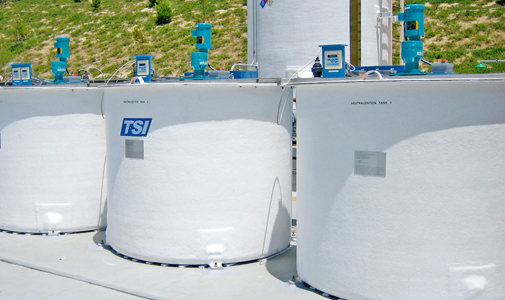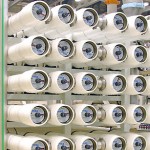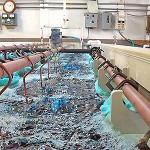Before wastewater can be reused or released to the municipal sewer or environment, it must be treated to acceptable standards. Depending upon the upstream process, this often entails the removal of solids or oils, and pH neutralization of the remaining wastewater. When a solution is neutral, its salt is formed from equal weights of acid and base, and pH or the measure of free acidity or alkalinity in water, is used to determine its state relative to a pH neutral value of 7.0. Measured on a scale of 0-14, solutions with a pH of 6.9 or less are acidic, and solutions with a pH of 7.1 or higher are alkali. Bases neutralize acids and acids neutralize bases. Hence, the task of a pH neutralization system is to measure and adjust the influent pH value to an acceptable range through the addition of acid or base, prior to discharging the treated effluent. Neutralization systems are made in two types including batch and continuous. In a batch system, influent fills the tank, the pH adjustment process begins and when the tank contents are neutralized, the treated effluent is discharged in a cycle. In a continuous system, the tank remains full all the time. As one gallon of influent enters the tank, one gallon of effluent exits the tank. If the pH of the influent differs from that within the tank, its quickly neutralized as it mixes. Both systems include a neutralization tank, acid and caustic metering pumps, mixer, pH controller and level sensor. The neutralization tank is typically a plastic or fiberglass tank with an open or enclosed top. The primary requirement for this application is to monitor the liquid level, ensuring that the levels are maintained within their operational ranges, and either emptying and refilling the batch system, or maintaining the level of the continuous system.
Technology
A short duration, high frequency ultrasonic sound wave is pulsed up to four times per second from the face of the transducer. The sound wave reflects off the surface of the liquid and returns to the transducer. The sensor measures the time of flight between the sound generation and receipt, and translates this into the distance between the transducer face and liquid surface. The distance is then converted into a percentage of measured span and output as a proportional 4-20 mA signal.
Best Practices
The installed level sensor must have a clear view of the liquid surface. This means that the measurement space beneath the level sensor should be free of any obstructions such as pipes, fittings, walls or mixers inside the tank. The level sensor must be located above the highest liquid level and never be submersed during normal operation. Neutralization tanks can be indoors or outdoors, which depending upon the level sensor’s location and type of installation, may result in the formation of water droplets or ice on the transducer that can affect acoustic transmission and receipt. Where so, select a level sensor with an appropriate weatherproof enclosure rating and longer more powerful measurement range. Apply a very thin layer of Rain-X or petroleum jelly water repellant across the transducer face and locate the level sensor so it’s not directly exposed to weather. Liquid is normally dispensed into neutralization tanks from the top and removed from the bottom. This often creates an agitated liquid surface during filling and a smooth liquid surface during emptying. During neutralization, the mixer is on, and depending upon the process, it may create significant agitation or foam. Foam absorbs the acoustic signal and can reduce the effective measurement range of the level sensor. Where significant agitation or foam exists, the level sensor should be installed in a stand-pipe to dampen turbulence and separate the surface foam from the point of measurement.
Installation
There are several ways to mount a level sensor in this application. Find a mounting location where the level sensor has a direct view of the liquid throughout the entire measurement span. The location must be flat, level to the liquid and accessible. The following equipment can be used to install the level sensor.
Tank Adapter
Tank adapters are recommended where the mounting location is level and not on a slope. Use a tank adapter that is slip x thread, and avoid thread x thread adapters. Do not use tank adapters that are mounted upside down.
Coupling
A shorter half coupling is preferred over a taller full coupling. Use a coupling that is slip x thread, and avoid thread x thread couplings. If you use a full coupling, it must follow the height and diameter restrictions described under Riser with Flange.
Riser with Flange
Long, narrow risers, which in fiberglass tanks may also extend a few inches inside the tank top, can affect acoustic transmission and receipt. The inner surface of the riser must be smooth and free of ridges, especially in the region below the installed transducer face. Risers with diameters of 3” or more are recommended. If the only option is a 2” diameter riser, the height of the riser and any mounting connections above it cannot exceed 5”. Caution should be taken with any riser heights greater than 8”, and the use of tee connections within the riser structure is not permissible.
Stand-Pipe
Level sensors can be installed in a stand-pipe to separate surface foam, dampen turbulence or maximize the acoustic signal strength of the level sensor. Do not use a stand-pipe in applications with dirty, coating or scaling liquids that will leave material build-up on the inner pipe wall. The stand-pipe must be one continuous section of smooth pipe without any breaks or transitions. The pipe’s inner diameter must be equal to or greater than the level sensors beam width and larger diameter pipes are recommended. To install the level sensor, mount a low-profile threaded coupling on top of the pipe. Just under the coupling, and within the level sensors dead band, drill two quarter inch vent holes on opposing sides of the pipe. The pipe should extend to the bottom of the tank, or at least below the level sensor’s measurement span. Cut a 45º angle on the bottom of the pipe. Finally, the level should be maintained above the 45º cut, so there’s always liquid in the pipe.
Side Mount Bracket
The Flowline side mount bracket can be used to install the level sensor against the side wall of the tank or an aperture extended over the tank.
Center of Dome Top Tank
Where possible, avoid installing the level sensor in the center of a dome top tank. The dome top acts like a parabolic reflector that amplifies acoustic energy and may cause the level sensor to perform intermittently at certain tank levels.
Electrical
Neutralization tanks may be located near large pumps, motors or variable frequency drives that can generate substantial EMI or RFI noise. Make sure that such devices are grounded to earth, and then ground the level sensor and associated electrical equipment to the same earth-ground as these devices. Some areas maybe subject to frequent lightning strikes or have un-reliable power. Where so, proper surge protection and filtering is recommended.
Span
The level sensor outputs a 4-20 mA current signal that’s proportionate to the measurement span within the tank. Users typically set the 4 mA to empty or the lowest measured level, and 20 mA to full or the highest measured level. Avoid placing the 4mA or 20mA span set points at or near levels where pumps, valves or alarms may actuate.
Interface
The level sensors 4-20 mA current signal is normally connected to a local controller or centralized control system. These devices may include a PLC, SCADA, DSC or stand-alone level controller. Either control device is fine as long as it accepts a 4-20 mA current signal. The operational range of the controller must then be programmed to match the measurement span of the level sensor, and take into account that the level sensors 4 mA set point is normally placed above the empty tank condition. Once the controllers operational range has been configured to the correct levels and engineering units, then the relay set points are applied for pump, valve or alarm automation. Remember, the primary control for this application is to monitor the liquid level, ensuring that the levels are maintained within their operational ranges, and either emptying and refilling the batch system, or maintaining the level of the continuous system. An independent high and low level alarm or safety shut off system should always be used in addition to the primary system.








